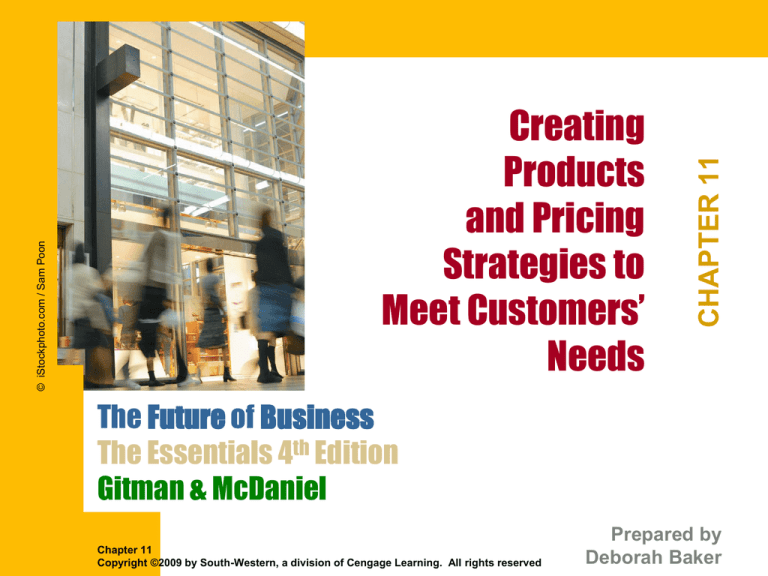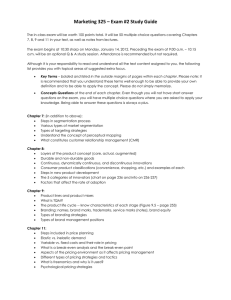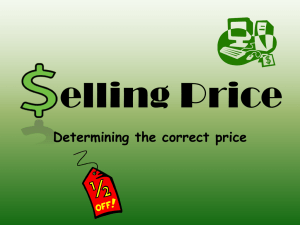
CHAPTER 11
© iStockphoto.com / Sam Poon
Creating
Products
and Pricing
Strategies to
Meet Customers’
Needs
The Future of Business
The Essentials 4th Edition
Gitman & McDaniel
Chapter 11
Copyright ©2009 by South-Western, a division of Cengage Learning. All rights reserved
Prepared by
Deborah Baker
CHAPTER 11
Learning Goals
1 What are the marketing concept and relationship
building?
2 How do managers create a marketing strategy?
3 What is the marketing mix?
4 How do consumers and organizations make
buying decisions?
2
CHAPTER 11
Learning Goals (continued)
5 What are the five basic forms of market
segmentation?
6 What is a product, and how is it classified?
7 How do organizations create new products?
8 What are the stages of the product life cycle?
9 What strategies are used for pricing products?
10 What trends are occurring in products
and pricing?
3
The Marketing Concept
marketing
The process of discovering the needs and wants
of potential buyers and customers and then
providing goods and services that meet or exceed
their expectations.
4
The Marketing Concept
exchange
The process in which two parties give something
of value to each other to satisfy their respective
needs.
5
Marketing: The “Right “ Principle
Getting
the right goods or services
to
the right people
at
the right place, time, and price
using
the right promotion techniques
6
The Marketing Concept
1
1
What are the marketing concept
and relationship building?
7
The Marketing Concept
Focusing on customer wants so the organization can
distinguish its products from competitors’ offerings.
Integrating all of the organization’s activities to
satisfy these wants.
Achieving long-term goals for the organization by
satisfying customer wants and needs legally and
responsibly.
1
8
The Marketing Concept
1
Customer
Value
The ratio of benefits to the sacrifice
necessary to obtain those benefits,
as determined by the customer.
Customer
Satisfaction
The customer’s feeling that a
product has met or exceeded
expectations.
Relationship
Marketing
A strategy that focuses on forging
long-term partnerships with customers
by offering value and providing
customer satisfaction.
9
CONCEPT check
Explain the marketing concept.
Explain the difference between customer value
and customer satisfaction.
What is meant by relationship marketing?
1
10
Creating a Marketing Strategy
2
2
How do managers create a marketing strategy?
11
The External Environment
environmental scanning
The process in which a firm continually collects
and evaluates information about its external
environment.
2
12
The External Environment
Social forces
Demographic forces
Economic forces
Technological forces
Political and legal forces
Competitive forces
2
13
© VANDERLEI ALMEIDA / AFP / Getty Images
Defining the Target Market
2
target market
The specific group
of consumers
toward which a firm
directs its
marketing efforts.
14
Creating a Competitive Advantage
competitive advantage
A set of unique features of a company and its
products that are perceived by the target market
as significant and superior to those of the
competition; also called differential advantage.
2
15
Creating a Competitive Advantage
2
Cost
Competitive
Advantage
A firm’s ability to produce a
product or service at
a lower cost than its competitors.
Differential
Competitive
Advantage
A firm’s ability to provide a unique
product or service that offers
something of value besides a
lower price.
Niche
Competitive
Advantage
A firm’s ability to target and
effectively serve a single segment of
the market within a limited
geographic area.
16
CONCEPT check
What is environmental scanning?
What is a target market, and why should a
company have one?
Explain the three types of competitive
advantages and provide examples of each.
2
17
Developing a Marketing Mix
3
3
What is the marketing mix?
18
Developing a Marketing Mix
marketing mix
The blend of product offering, pricing,
promotional methods, and distribution system
that brings a specific group of consumers
superior value.
3
19
Elements of the Marketing Mix
3
Product
Price
Promotion
Place
20
CONCEPT check
What is meant by the marketing mix?
What are the components of the marketing mix?
How can marketing techniques help not-for-profit
organizations?
3
21
Buyer Behavior
4
4
How do consumers and organizations make
buying decisions?
22
Buyer Behavior
buyer behavior
The actions people take in buying and using
goods and services.
4
23
Consumer Decision-Making Process
(1)
Need Recognition
Cultural, social,
individual and
psychological
factors
affect
all steps
(2)
Information Search
(3)
Evaluation of Alternatives
(4)
Purchase
(5)
Postpurchase Behavior
4
Exhibit 11.2
24
Influences on Consumer Decision Making
Cultural Factors
Social Factors
Individual Influences
Psychological Influences
4
25
Characteristics of the Business- to-Business Market
Purchase Volume
Number of Customers
Location of Buyers
Direct Distribution
4
26
CONCEPT check
Explain the consumer decision-making process.
How do business markets differ from consumer
markets?
4
27
Market Segmentation
5
5
What are the five basic forms of market
segmentation?
28
Market Segmentation
5
Demographic
Age, education, gender, income,
race, social class, household size
Geographic
Regional location, population density,
city/county size, climate
Psychographic
Lifestyle, personality, interests,
values, attitudes
Benefit
Benefits provided by the
good or service
Volume
Amount of use (light versus heavy)
29
Example of Age Segmentation
5
Frito-Lay
Product
Demographic
Snack Niche
Frito
33-51 years
males
Hunger
satisfaction
Doritos
Teens
mostly males
Bold and daring
snacking
Tostitos
Upscale, born
from 1946-1964
Casual interaction,
social food
30
Exhibit 11.4
Using Marketing Research
5
Survey
research
Data is gathered from
respondents to obtain facts,
opinions, and attitudes.
Observation
research
An investigator monitors
respondents’ actions without
interacting directly with
respondents.
Experiment
An investigator changes one or
more variables while observing
the effects of these changes on
another variable.
31
CONCEPT check
Define market segmentation.
List and discuss the five basic forms of market
segmentation.
How does market research help companies make
better use of their marketing budgets?
5
32
What is a Product?
6
6
What is a product, and how is it classified?
33
What is a Product?
product
In marketing, any good or service, along with its
perceived attributes and benefits, that creates
value for the customer.
6
34
Consumer Product Classifications
Unsought
Product
6
Products that either are unknown to
the buyer or are known but the
buyer does not actively seek them.
Convenience
Product
Relatively inexpensive items that require
little shopping effort and are purchased
routinely without planning.
Shopping
Product
Items that are bought after considerable
planning, including comparisons of
price, suitability, and style.
Specialty
Product
Items for which consumers search
long and hard and for which they
refuse to accept substitutes.
35
Consumer Product Classifications
Degree of Effort
Required
Examples
Unsought
Products
No effort
Life insurance
Burial plots
New products
Convenience
Products
Very little or
minimum effort
Soft drinks
Bread, milk
Coffee
Shopping
Products
Considerable
effort
Automobiles
Homes
Vacations
Specialty
Products
Maximum
effort
Expensive jewelry
Gourmet dinners
Limited-production
Consumer
Product
6
36
Exhibit 11.6
Classifying Business Products
capital products
Large, expensive items with a long life span that
are purchased by businesses for use in making
other products or providing a service.
expense items
Items, purchased by businesses, that are smaller
and less expensive than capital products and
usually have a life span of less than one year.
6
37
Industrial Product Classifications
1. Installations
2. Accessories
3. Component parts and materials
4. Raw materials
5. Supplies
6
6. Services
38
CONCEPT check
What is a product?
What are the classes of consumer goods?
Explain how business products are classified.
6
39
Creating Products That Deliver Value
7
7
How do organizations create new products?
40
Focus Group
focus group
A group of 8 to 12 participants led by a moderator
in an in-depth discussion on one particular topic
or concept.
7
41
Brainstorming
brainstorming
A method of generating ideas in which group
members suggest as many possibilities as they
can without criticizing or evaluating any of the
suggestions.
7
42
Product Manager
product manager
The person who develops and implements a
complete strategy and marketing program for a
specific product or brand.
7
43
CONCEPT check
How do companies organize for new-product
development?
What are the steps in the new-product
development process?
Explain the role of the product manager.
7
44
The Product Life Cycle
8
8
What are the stages of the product life cycle?
45
The Product Life Cycle
product life cycle
The pattern of sales and profits over time for a
product or product category.
Consists of:
•
introduction
•
growth
•
maturity
•
decline
8
46
The Product Life Cycle
Introduction
8
Light competition
Frequent product modifications
Limited distribution
Heavy promotion
High failure rate
High production and marketing
costs
Low sales volume
Small or negative profits
© The Coca-Cola Company via Getty Images
47
The Product Life Cycle
Growth
8
Sales grow at an increasing rate
Healthy profits
Many competitors enter market
Large companies may acquire pioneering firms
Promotion emphasizes aggressive brand ads
and the differences between brands
Adequate distribution is a major key to success
Prices normally fall at end of growth phase
Priority is increasing/retaining market share and
enhancing profits
48
The Product Life Cycle
Maturity
8
Sales growth—but at a decreasing rate
Saturated markets
Product line extensions through product variations
Global introduction of products
49
The Product Life Cycle
Decline
Sales and profits fall
Trade allowances eliminated
Most advertising and sales promotions eliminated
The rate of decline is governed by:
8
Rate of change in consumer tastes
Rate at which new products are introduced
50
CONCEPT check
What is the product life cycle?
Describe each stage of the product life cycle.
What are the marketing strategies for each stage
of the product life cycle?
8
51
Pricing Strategies
9
9
What strategies are used for pricing products?
52
Pricing Strategies
price skimming
Introducing a product with a high initial price and
lowering the price over time.
penetration pricing
Selling new products at low prices in the hope of
achieving a large sales volume.
9
53
Pricing Strategies
leader pricing
The strategy of pricing products below the normal
markup or even below cost to attract customers to
a store where they would not otherwise shop.
bundling
The strategy of grouping two or more related
products together and pricing them as a single
product.
9
54
Pricing Strategies
odd-even pricing
The strategy of setting a price at an odd number
to connote a bargain and at an even number to
suggest quality.
prestige pricing
The strategy of increasing the price of a product
so that consumers will perceive it as being of
higher quality, status, or value.
9
55
CONCEPT check
What is the difference between penetration pricing
and price skimming?
Explain the concept of price bundling.
Describe odd-even pricing and prestige pricing.
9
56
Trends in Developing Products and Pricing
10
10
What trends are occurring in products
and pricing?
57
Trends in Developing Products and Pricing
Internet
One-to-One Marketing
10
58
Trends in Developing Products and Pricing
one-to-one marketing
Creating a unique marketing mix for every
customer.
10
59
The Impact of the Internet on Pricing
Buyers can compare products and prices
Sellers can collect detailed data about
customers’ buying habits
Sellers can monitor the competition’s
prices
10
60
Trends in Developing Products and Pricing
product line (or brand) extension
Taking a product with a well-developed brand
image and using that brand name for a new
product in either the same product category or a
different product category.
10
61
Trends in Developing Products and Pricing
private-label branding
Where a retailer, or wholesaler, has a
manufacturer produce products and the retailer,
or wholesaler, puts its own name on the item.
10
62
CONCEPT check
How have online price-comparison engines
helped consumers shop for the best price?
Describe one-to-one marketing and the role of
marketing databases.
10
63







